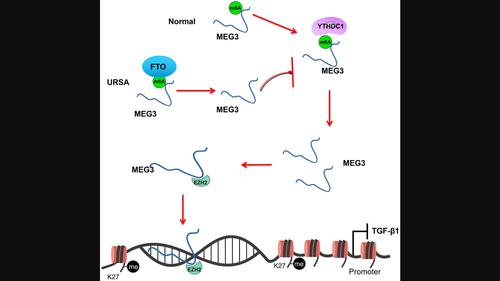当前位置:
X-MOL 学术
›
FEBS Journal
›
论文详情
Our official English website, www.x-mol.net, welcomes your feedback! (Note: you will need to create a separate account there.)
FTO protein regulates the TGF-β signalling pathway through RNA N6-methyladenosine modification to induce unexplained recurrent spontaneous abortion
FEBS Journal Pub Date : 2024-01-20 , DOI: 10.1111/febs.17053 Jun Zhang 1 , Xinqiong Liu 1 , Yali Gao 2
FEBS Journal Pub Date : 2024-01-20 , DOI: 10.1111/febs.17053 Jun Zhang 1 , Xinqiong Liu 1 , Yali Gao 2
Affiliation

|
Recent studies have revealed the involvement of RNA m6A modification in embryonic development; however, the relationship between aberrant RNA m6A modification and unexplained recurrent spontaneous abortion (URSA) remains unclear. In this study, we analysed the level of RNA m6A modification in trophoblasts using dot blot, RNA m6A quantification, and MeRIP assays. By integrating data from the GEO database, RNA-Seq, and MeRIP-Seq, we examined the aberrant expression of m6A methyltransferases and their downstream molecules in chorionic villus (placental) tissues. RNA pull-down, RIP, and electrophoretic mobility shift assay were used to analyse the binding relationship between the YTHDC1 protein and MEG3. Additionally, RNA stability and BrU immunoprecipitation chase assays were utilised to elucidate the regulation of MEG3 stability by YTHDC1. ChIP and DNA pull-down RNA experiments were performed to elucidate the mechanism by which MEG3 targets EZH2 to the TGF-β1 promoter. The results showed that the expression of the m6A demethylase FTO protein was significantly increased in URSA trophoblasts, leading to inhibition of the MEG3 m6A modification and weakening of the stabilising effect of the m6A binding protein YTHDC1 on MEG3. Furthermore, MEG3 was found to bind simultaneously with the EZH2 protein and the TGF-β1 gene promoter, enabling the localisation of EZH2 protein to the TGF-β1 gene promoter and subsequent inhibition of TGF-β1 gene expression. In summary, our findings elucidate the mechanism by which FTO protein regulates the MEG3-TGF-β signalling pathway, thereby suppressing trophoblast invasion and proliferation in URSA trophoblast cells. These findings provide new insights for the treatment of URSA.
中文翻译:

FTO蛋白通过RNA N6-甲基腺苷修饰调节TGF-β信号通路诱导不明原因复发性流产
最近的研究揭示了 RNA m6A 修饰参与胚胎发育;然而,异常 RNA m6A 修饰与不明原因复发性流产 (URSA) 之间的关系仍不清楚。在本研究中,我们使用斑点印迹、RNA m6A 定量和 MeRIP 测定分析了滋养层中 RNA m6A 修饰的水平。通过整合来自 GEO 数据库、RNA-Seq 和 MeRIP-Seq 的数据,我们检查了绒毛膜绒毛(胎盘)组织中 m6A 甲基转移酶及其下游分子的异常表达。采用RNA Pull-down、RIP和电泳迁移率变动分析方法分析YTHDC1蛋白与MEG3之间的结合关系。此外,还利用 RNA 稳定性和 BrU 免疫沉淀追踪分析来阐明 YTHDC1 对 MEG3 稳定性的调节。进行 ChIP 和 DNA Pull-down RNA 实验以阐明 MEG3 将 EZH2 靶向 TGF-β1 启动子的机制。结果表明,URSA滋养层中m6A去甲基化酶FTO蛋白的表达显着增加,导致MEG3 m6A修饰受到抑制,m6A结合蛋白YTHDC1对MEG3的稳定作用减弱。此外,发现MEG3同时与EZH2蛋白和TGF-β1基因启动子结合,使EZH2蛋白定位于TGF-β1基因启动子并随后抑制TGF-β1基因表达。总之,我们的研究结果阐明了 FTO 蛋白调节 MEG3-TGF-β 信号通路,从而抑制 URSA 滋养层细胞中滋养层侵袭和增殖的机制。这些发现为 URSA 的治疗提供了新的见解。
更新日期:2024-01-20
中文翻译:

FTO蛋白通过RNA N6-甲基腺苷修饰调节TGF-β信号通路诱导不明原因复发性流产
最近的研究揭示了 RNA m6A 修饰参与胚胎发育;然而,异常 RNA m6A 修饰与不明原因复发性流产 (URSA) 之间的关系仍不清楚。在本研究中,我们使用斑点印迹、RNA m6A 定量和 MeRIP 测定分析了滋养层中 RNA m6A 修饰的水平。通过整合来自 GEO 数据库、RNA-Seq 和 MeRIP-Seq 的数据,我们检查了绒毛膜绒毛(胎盘)组织中 m6A 甲基转移酶及其下游分子的异常表达。采用RNA Pull-down、RIP和电泳迁移率变动分析方法分析YTHDC1蛋白与MEG3之间的结合关系。此外,还利用 RNA 稳定性和 BrU 免疫沉淀追踪分析来阐明 YTHDC1 对 MEG3 稳定性的调节。进行 ChIP 和 DNA Pull-down RNA 实验以阐明 MEG3 将 EZH2 靶向 TGF-β1 启动子的机制。结果表明,URSA滋养层中m6A去甲基化酶FTO蛋白的表达显着增加,导致MEG3 m6A修饰受到抑制,m6A结合蛋白YTHDC1对MEG3的稳定作用减弱。此外,发现MEG3同时与EZH2蛋白和TGF-β1基因启动子结合,使EZH2蛋白定位于TGF-β1基因启动子并随后抑制TGF-β1基因表达。总之,我们的研究结果阐明了 FTO 蛋白调节 MEG3-TGF-β 信号通路,从而抑制 URSA 滋养层细胞中滋养层侵袭和增殖的机制。这些发现为 URSA 的治疗提供了新的见解。



























 京公网安备 11010802027423号
京公网安备 11010802027423号